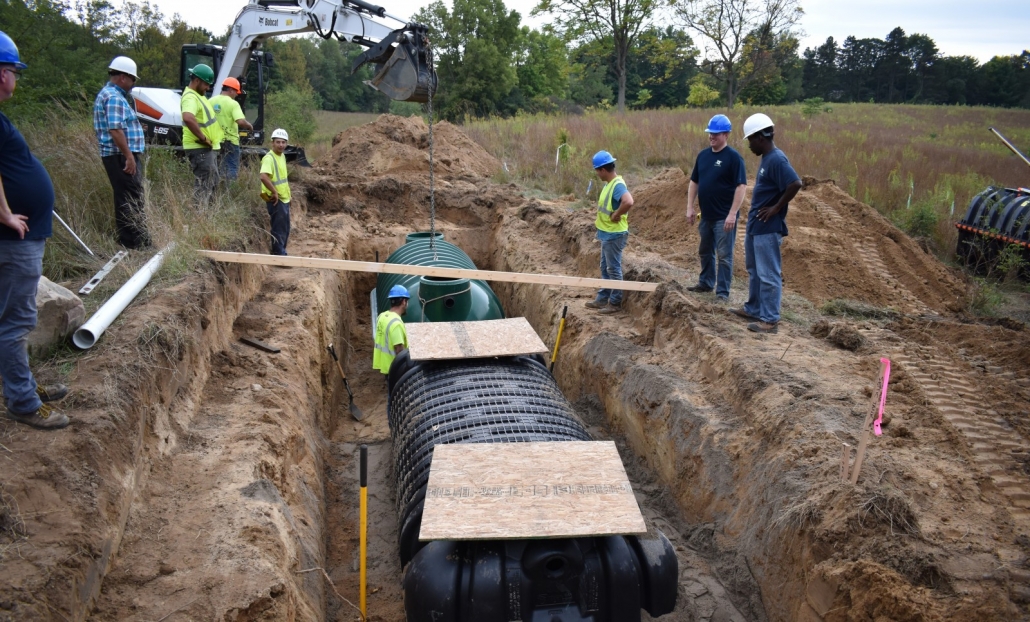
Installation of the Fenner Nature Center onsite wastewater treatment system (Photo courtesy of Larry Stephens)
The Great Lakes News Collaborative includes Bridge Michigan; Circle of Blue; Great Lakes Now at Detroit Public Television; and Michigan Radio, Michigan’s NPR News Leader; who work together to bring audiences news and information about the impact of climate change, pollution, and aging infrastructure on the Great Lakes and drinking water. This independent journalism is supported by the Charles Stewart Mott Foundation.
Natasha Blakely, Great Lakes Now
In Michigan, with public health departments fully occupied with COVID-19, septic systems have been pushed back as a priority.
But even before COVID-19, it wasn’t much of a priority in the Legislature, because the last time an attempt was made to get Michigan statewide regulations for septic systems was in 2018.
Rep. Abdullah Hammoud, D-Dearborn, and former Rep. James Lower, R-Cedar Lake, introduced House Bills 5752 and 5753.
The bills in question would have established state standards for septic systems, also known as “onsite wastewater systems,” and also have required regular inspections of those systems with the results of those inspections maintained by the then-Michigan Department of Environmental Quality. Under the measures, a committee would have advised the DEQ, now the Michigan Department of Environment, Great Lakes, and Energy, on standards.
Both bills made it to the House Committee on Local Government before stalling in late 2018 and then going no further.
“In negotiations that’s where it fell apart,” Hammoud said. “Ultimately the differences stemmed from what would trigger an inspection of a septic tank. Is it an interval inspection system where every three years you have to have an inspection? Is it point of sale, you sell your house? Is it if there is a public health crisis, contamination of a nearby water system that would then trigger an inspection of all nearby septic tanks? Obviously every stakeholder group has their own differences of opinion as to what they prefer or not prefer for their members, and that is where the conversation unraveled.”
That point of contention seems characteristic of most of the discussions happening around a statewide code so far.
“To some extent, individual property rights enter the picture,” said Larry Stephens, past president of the Michigan Onsite Wastewater Recycling Association. “There’s always some pushback there. And how that program is administered and who pays for it and how it gets done are large issues.”
Stephens, a professional engineer, is president of Stephens Consulting Services. What people do agree on, he says, is the need for better training and education and a statewide code that can give some assurance to people on quality control of industry workers like designers, contractors, regulators and operators of advanced treatment systems.
What can go wrong with a septic system can vary a lot. Stephens listed a few examples.
It might be that the septic tank itself is in poor condition. Or there might not be a drain field because it is an old property that predates the relevant ordinances. There are old inherited systems that were put in without permits. In each of those cases, the septic system might be discharging into surface waters, farm drains, storm sewers or somebody’s yard.
Those issues tend to be found through a point-of-sale inspection or a complaint from a neighbor, Stephens said.
Michigan’s Washtenaw County, where the University of Michigan is located, has an ongoing Time of Sale program that began in 2000. Within the first 18 months of the program, the county found that 18% of inspected septic systems were failing or inadequate.
Point-of-sale inspections do end up being useful in that way. However, it still remains a point of contention for many people.
In south central Michigan, the Barry-Eaton District Health Department assessed 9,443 sewage systems through its Time of Sale or Transfer program, with corrective action required for 27% of that, according to BEDHD’s 2017 10-year report.
However, the program received community blowback. The report states that some residents felt the TOST program was “undermining private property ownership and sale/transfer rights.”
A year after the 10-year report, in 2018, the program was repealed.
Some of that blowback stems from the cost of repairing or replacing septic systems, which often hit the five-figure range.
“Mandating something because you want to have this nice, pristine upper-income inland lake is one thing. But ignoring the fact that downstream there’s a whole bunch of people living with pretty shitty systems that are affecting the environment just as much, if not the public health?” said Dendra Best, executive director of nonprofit Wastewater Education. “It comes down to what’s fair, what’s environmentally necessary, what is affordable.”
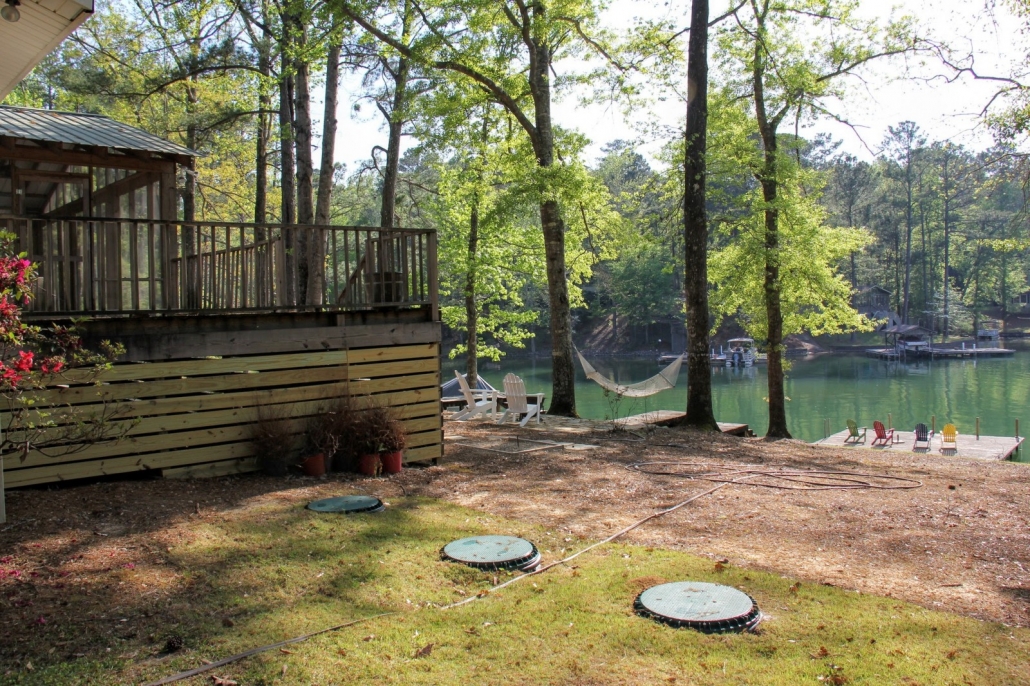
Residential septic system (Photo by John Coley via Flickr, CC BY 2.0)
The regulations already in place
The scale of the issue is large. Michigan has between 1.3 and 1.4 million onsite septic systems and 35% of its residents rely on septic systems, according to EGLE.
And though Michigan does not have a statewide code, there are local ordinances that relate to septic systems.
Municipal health departments, for example, regulate residential onsite systems. Any system installed in Michigan needs to meet permitting requirements from the local health department or the state of Michigan. The state also has an overarching statewide regulation over discharges to Michigan surface water and groundwater.
The closest efforts that EGLE has to maintaining some form of consistency over septic regulations is through the Michigan Local Public Health Accreditation Program. Started in 1998, the Michigan Department of Health & Human Services, the Michigan Department of Agriculture and Rural Development, EGLE and local health departments work together to evaluate and accredit local health departments’ septic regulations on a three-year cycle.
“We review the local health department for a legally adopted sanitary code or regulation,” said Dale Ladouceur, a specialist with EGLE’s Onsite Wastewater Program. “They have to have that. It’s one of the pieces we look for. We look for provisions in their code for enforcement, so if there’s a public health concern, issue that needs to be addressed, they have provisions in their code to address it. We look for evidence of enforcement. Those are three key pieces under their local regulation that we are reviewing.”
Ladouceur was involved with the program as a local health department employee in 1998 before shifting to work for the state in 2000, and he remembers the huge variability in documentation of septic systems that there used to be.
“Since the inception, it has made huge gains in consistency and documentation, in clarity, not only for local health departments but for the state reviewers,” he said.
That sort of documentation helps because health departments are then able to find information quick on where septic systems are in relation to other potential impacts, such as wells, surface water or other septic systems – useful when a resident is trying to replace or install a well or septic system of their own.
But even with increased consistency, that’s still 45 health department jurisdictions with different codes to be evaluated.
“It does become challenging when we go from jurisdiction to jurisdiction, recognizing that there are differences in their sanitary codes,” Ladouceur said. “The onsite wastewater program is a small program of primarily four staff evaluating the local health department jurisdictions across the state.”
Aside from the accreditation program, EGLE receives data from local health departments on a quarterly basis, which it uses for trend analysis and funding decisions, according to Nick Assendelft, public information officer with EGLE.
“Having said that, we’re working with local health departments to standardize the information so that it can be used in a more consistent fashion. Right now, there are differences in interpretation and differences in county sanitary codes, so this information is not as comprehensive or valuable as it could be,” Assendelft said in an email.
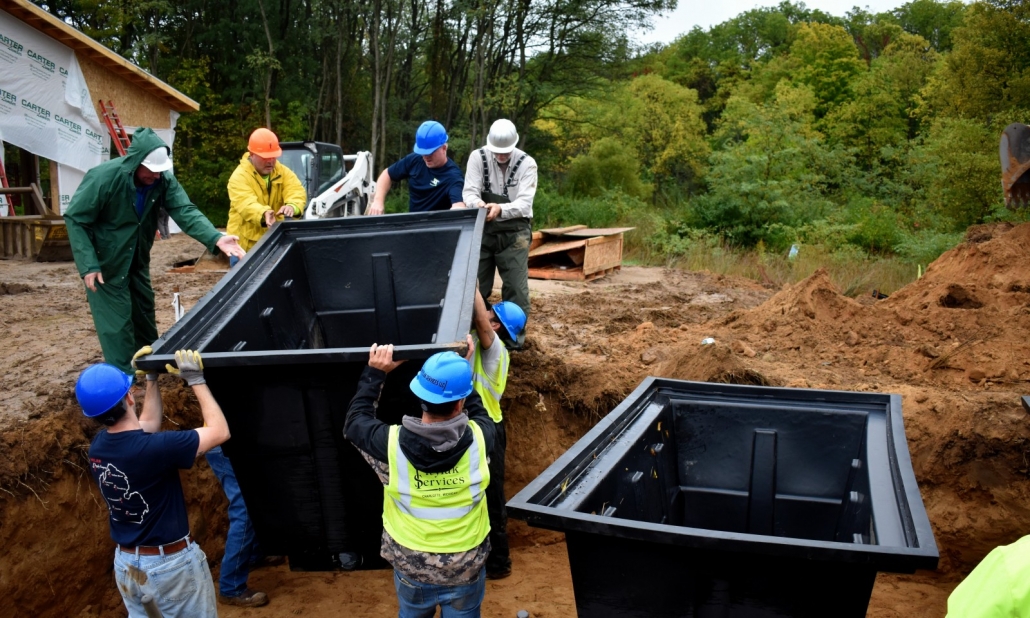
Installation of the Fenner Nature Center onsite wastewater treatment system (Photo courtesy of Larry Stephens)
Inconsistent individual code
Having different codes for each county also makes the process more complicated for those working in the private sector of the industry.
“One of the problems of not having a uniform statewide code is that we don’t have any leadership with regard to programming, a program to assure quality of onsite systems,” Stephens said. “When you have multiple counties next to one another, one county will approve certain types of systems and the other county will not and will approve other types of systems, and many times separated by only a road. It makes it very frustrating for those of us in the private industry to get anything done or to really deal with all the variability in codes and the administration of those codes.”
The standards permitted by one county department might be a system that costs between $7,000 and $10,000 while others permit ones that can go up to $80,000, Stephens added.
“It’s unreal,” he said.
The Michigan Onsite Wastewater Recycling Association is trying to change that through educational efforts. MOWRA helps host the Michigan Onsite Wastewater Conference each year, an educational conference for the industry and interested parties to learn about latest industry trends and regulatory changes.
“We’re not reaching everyone, but we do make progress,” Stephens said. “We do get to feel more comfortable with what they’re doing.”
MOWRA also worked with the Fenner Nature Center in Lansing to construct a point-of-use wastewater treatment and re-use demonstration and training tool in its new multi-purpose pavilion in 2019 to aid in educational efforts. MOWRA assisted with funding, and Stephens Consulting Services designed the system.
And when there’s a bill circulating, MOWRA helps lobby for it.
But though there isn’t another bill circling in the Legislature yet, there are still people on the citizen level working toward their goal of a statewide standard.
Wastewater Education is one such group.
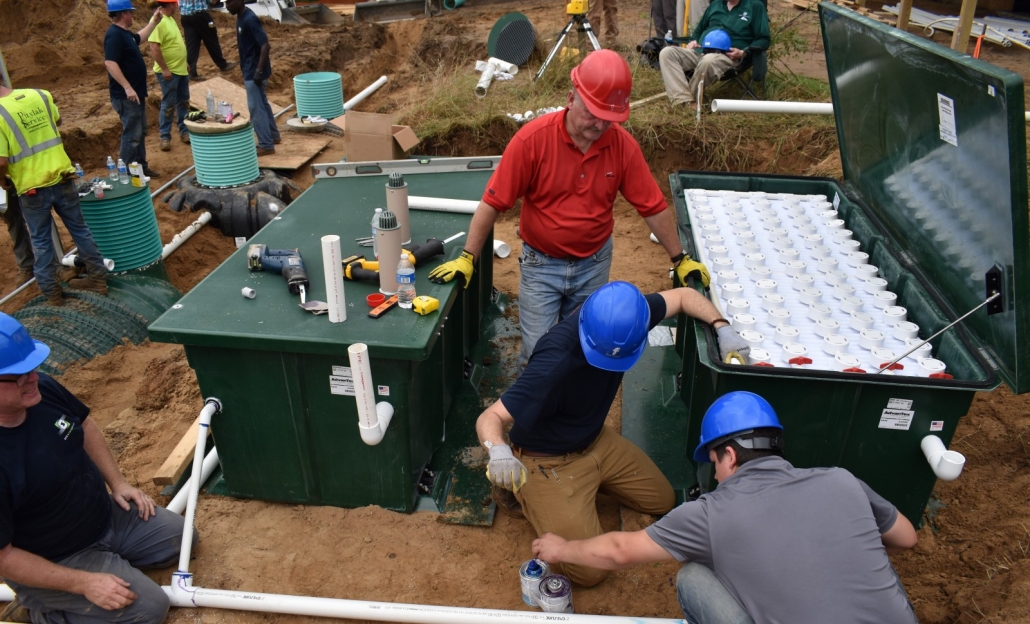
Installation of the Fenner Nature Center onsite wastewater treatment system (Photo courtesy of Larry Stephens)
Building the foundation of a statewide code
The current iteration of Wastewater Education’s efforts to develop a statewide code for onsite wastewater systems in Michigan is an interactive online process. Though the process began in early 2020 with about 70 people, COVID-19 meant that Wastewater Education has only recently restarted this attempt to cooperatively develop a code.
Housed on a private site – onsitewastewaterinfo.wordpress.com – anyone who wants to get involved or give input is welcome to join the process.
Wastewater Education is a nonprofit that started in 2003 as the Northwest Michigan Onsite Wastewater Task Force under a grant from the Joyce Foundation.
But now Wastewater Education’s mission goes beyond just northwest Michigan.
“When you are looking at instituting something on a statewide basis, you have to take into account everybody that has a piece of that, that what you hope will end up being an accepted, workable solution,” Best said.
As Best put it, pushing for legislation without considering all the parts that will eventually be involved is like giving birth to a baby, and then giving the child to someone else to figure out feeding, clothing it and financing expenses like childcare, education and a wedding.
“It’s not going to work, because it can’t work,” she said. “Because there’s no infrastructure in place to put what you want to have done on an equitable, manageable footing.”
A broad invite to the website was sent to various entities that had a stake in the situation and everyone involved in the live events Wastewater Education hosted before COVID-19 hit.
How the process works:
- Anyone can request an invite to access onsitewastewaterinfo.wordpress.com, where they can make a free account.
- Specific web pages, linked from the homepage, allow visitors to comment on various sections of the potential legislation. These include regulation, administrative actions, enforcement and funding structures.
- Discussion pages for subsections are opened every week or so.
Once a section has been discussed, the plan is to organize a video conference discussion to reach consensus on that section of the legislation.
“Consensus means that you don’t get 100% of what you want,” Best said. “Do we have a majority consensus that this is a workable option? In this case, yes, majority does rule, because eventually that’s that majority that’s going to have to do the job. And if you’ve created something that is unworkable or that people ignore, what’s the point of having it? It has to be accepted and acceptable.”
That’s something that Best emphasized, that just because a state has statewide regulations doesn’t mean they’re effective or enforced.
“There are some (states) that still have county differences,” Best said. “You could literally sort of step across this imaginary line and not be able to do A when it’s perfectly acceptable in B.”
Then you have states like Ohio and Minnesota, which Best pointed to as examples of states that have handled their states’ septic regulations well.
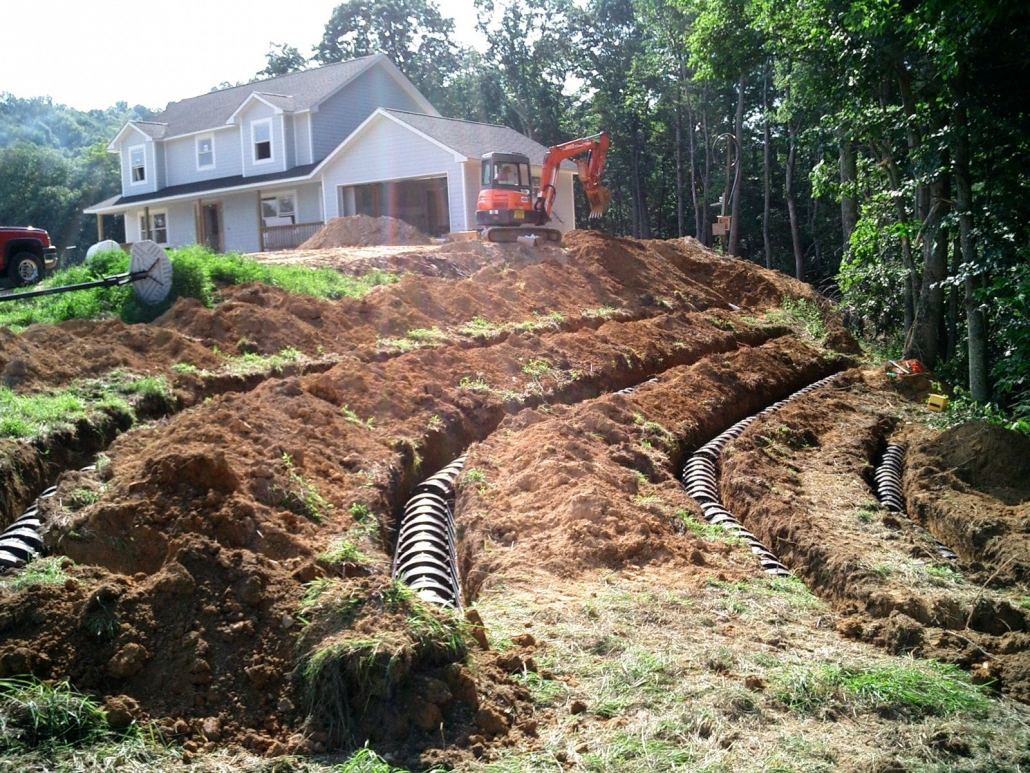
Septic system installation on a steep slope (Photo by Soil Science via Flickr, CC BY 2.0)
University, community, state
“The reason why septic systems got attention in the ‘70s was (researchers) were noticing around many of our lakes, they were getting greener, and typically the lower half of Minnesota is pretty heavy ag,” said Sara Heger, a researcher and instructor with the University of Minnesota’s Onsite Sewage Treatment Program.
The university started doing septic system training in 1974. Some counties started requiring certification, but the state code was voluntary until 1996 when Minnesota’s state legislature made state rules and licensing mandatory.
“We are the primary education provider to become certified, so that really grew our programs,” Heger said.
Among the research the university is conducting related to septic systems is alternative technology for when conventional systems might not work, the movement of contaminants of emerging concern through systems, impacts on the water table and soil conditions, and an ongoing research relationship with the Minnesota Department of Transportation, looking into aspects like septic systems at truck stops.
The University of Minnesota also is involved in efforts to help educate the public including free workshops, educational videos and online advice on many aspects of septic system ownership, including cost, questions to ask professionals, household tips and even a section specifically for real estate agents.
“On a day-to-day basis, the homeowners are the operators,” Heger said. “We can have the best regulations, the best systems in the ground, but if they’re not taken care of properly, they won’t last and they won’t treat with optimum efficiency.”
She related sewer systems maintenance to other things people have to account for on a regular basis – giving your car an oil change or maintaining the roof of your home.
“If your roof leaks, it could ruin your house,” she said. “If the septic system leaks, it could be leaking sewage into your home or it’s essentially polluting the environment. So the ramifications of that system not working are really high, but I think out of sight, out of mind to a lot of people.”
Minnesota’s efforts around septic systems seem to be working – the estimated percentage of septic systems compliant with state law “increased from approximately 74% in 2010 to 81% in 2019,” according to the Minnesota Pollution Control Agency’s 2019 Subsurface Sewage Treatment Systems annual report.
COVID-19, cost, climate change remain as barriers
The 2021 Michigan Onsite Wastewater Conference was canceled due to COVID-19 and Wastewater Education’s efforts to create a set of regulations were postponed, but the pandemic has had a harsher effect on the industry than some missed events.
“This has pretty much become a very back issue for the public health department,” Best said. “Ultimately this falls under the public health code. It has to be part of the public health code, and they just don’t have the time. Right now, they don’t have the time and the inclination and the manpower to deal with anything other than COVID.”
Even if the public health departments get involved, cost remains an issue.
“The problem is, we can enact all of the legislation, all of the local rules that we want, that says if your home or property is in this condition, you will, you shall, you must do this amount of upgrade. But we haven’t provided them any funds to do it. And if they had the funds to do it, they would probably have done it in the first place,” Best said.
The goal for Wastewater Education is an affordable and manageable system that can include a fund to help people upgrade their systems when needed.
That latter part is something that could become a reality soon. Michigan Gov. Gretchen Whitmer announced the MI Clean Water Plan last fall, which includes $35 million for a low-interest loan program for homeowners replacing failing septic systems.
And climate change, while a concern for many people, is still a topic with many unanswered questions regarding its impact on septic systems.
“Climate change is something we all have to keep in mind in the septic system industry, but it has the potential to impact us all differently across the U.S.,” Heger said. “There are concerns about more moisture and how that may impact soil treatment, but there is an added benefit of warmer soil which is beneficial for septic systems. Regulations across the US need to be updated to reflect our current understanding of science and climate change should be a factor. How much of one remains to be seen but having conservative regulations will allow for more flexibility.”
Capacity remains an issue for the industry when dealing with other external factors like climate change. The people more concerned over its impact on septic systems are currently the people who live close enough to the lakes to be affected by the high water levels, but the industry otherwise mostly has its hands full, according to Stephens.
“I would suggest that climate change is not a driving factor right now for the onsite industry, because we have so much catching up to do that it’s not impacting our onsite systems, with the exception of those that may be impacted because we’re losing shoreline around the Great Lakes,” Stephens said.
The Great Lakes News Collaborative includes Bridge Michigan; Circle of Blue; Great Lakes Now at Detroit Public Television; and Michigan Radio, Michigan’s NPR News Leader; who work together to bring audiences news and information about the impact of climate change, pollution, and aging infrastructure on the Great Lakes and drinking water. This independent journalism is supported by the Charles Stewart Mott Foundation.








